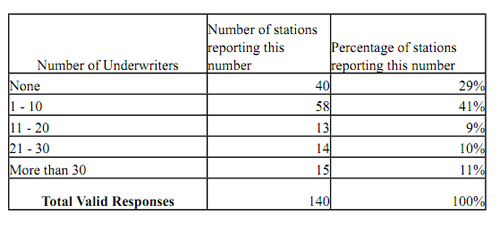Underwriting represents a very modest percentage of the budget of most Low Power FM radio stations in the United States. So reports the Prometheus Radio Project in a filing to the Federal Communications Commission. The latest data comes from a 2011 study conducted by Prometheus in collaboration with Keith Brand, Associate Professor of Radio, Television and Film at Rowan University. Brand produced a similar study in 2004.
The 2011 survey team managed to contact 149 LPFM stations. Among the study’s findings: 31 percent of the stations reported no income from underwriting. Another 32 percent disclosed that between one to 25 percent of their budget came from underwriting. Nine percent acknowledged that 26 to 50 percent of their budget came from underwriting.
Bottom line: 72 percent of these signals reported that less than 50 percent of their income came from an underwriting source.
“Based on the budget ranges provided by the stations which answered this question, we calculate the total number of underwriting dollars for these respondents as $947,000,” Prometheus’s Brandy Doyle writes. “If these responses hold for all LPFM stations, then the underwriting revenue for the LPFM service as a whole would be approximately $7,284,615. To put this in context of commercial broadcast radio advertising revenue, this number represents .0005% of the over $15 billion in revenue for U.S. commercial radio in 2010, a negligible amount.”
Thus, “LPFM stations are highly unlikely to have a detrimental economic impact on full power commercial stations.”
Why is this even a question? Prometheus filed the data in an FCC proceeding titled the “Economic impact of Low-Power FM Stations on Full-Service Commercial FM Stations.” Congress required the Commission to conduct the inquiry when it authorized more LPFM stations earlier this year. If you’ve been waiting for the National Association of Broadcaster’s shoe to drop, here it comes.
In its comments in the proceeding, the NAB wants the FCC to pay particular attention to the impact that new LPFM’s might have on commercial “niche” stations:
NAB agrees that some advertisers who now reach minority or niche audiences over commercial stations may divert their radio budgets to underwriting of LPFM stations. Even if that does not occur, however, a lowpower station that diverts audiences from a full-service station will reduce the full-service station’s advertising revenues because the full-service station may no longer garner as many listeners, regardless of whether particular advertisers choose to support the LPFM station. Particularly for full-service stations serving niche audiences, the loss of listeners may reduce advertising revenues to a point where the station is no longer financially viable or where it would be forced to change to a more mainstream format.
To which Prometheus responds:
The Commission’s role is not to protect incumbent stations from competitors, but to ensure that licensees serve the public interest. The LPFM service is relatively new, and has been hampered by restrictions that relegate LPFM stations to rural areas. It is our hope that both existing and future LPFM stations will continue to grow in their community impact, and in some cases, this growth will include larger budgets and increased revenue from underwriting. Such growth will likely create a positive economic impact in the communities where stations are located. In the long term, new LPFM stations may indeed have a positive economic impact on their full power commercial neighbors as well, by pushing radio to return to its roots of local community service and keeping broadcasting relevant.



